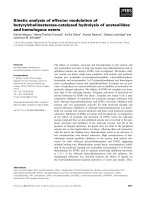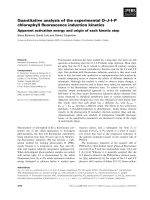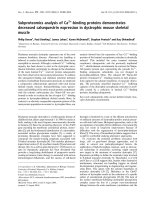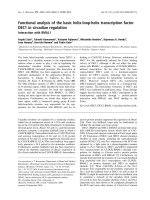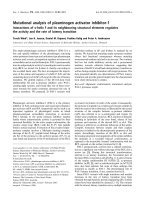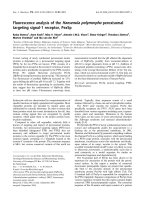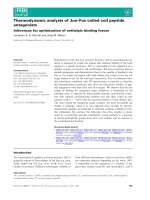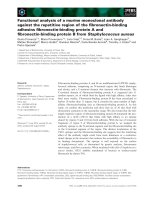Báo cáo khoa học: "Phylogenetic analysis of Newcastle disease viruses isolated from waterfowl in the Upper Midwest Region of the United States" potx
Bạn đang xem bản rút gọn của tài liệu. Xem và tải ngay bản đầy đủ của tài liệu tại đây (329.32 KB, 9 trang )
BioMed Central
Page 1 of 9
(page number not for citation purposes)
Virology Journal
Open Access
Research
Phylogenetic analysis of Newcastle disease viruses isolated from
waterfowl in the Upper Midwest Region of the United States
Naresh Jindal, Yogesh Chander, Ashok K Chockalingam, Martha de Abin,
Patrick T Redig and Sagar M Goyal*
Address: Department of Veterinary Population Medicine, College of Veterinary Medicine, University of Minnesota, 1333 Gortner Avenue, Saint
Paul, MN, 55108, USA
Email: Naresh Jindal - ; Yogesh Chander - ; Ashok K Chockalingam - ; Martha de
Abin - ; Patrick T Redig - ; Sagar M Goyal* -
* Corresponding author
Abstract
Background: This study was conducted to characterize Newcastle disease virus (NDV) isolates
obtained from waterfowl from the Upper Midwest region of the United States. A total of 43 NDVs
were isolated by inoculation of cloacal samples in embryonated chicken eggs. These isolates were
obtained from 24 mallards, seven American green-winged teals, six northern pintails, four blue-
winged teals, and two wood ducks. Partial sequences of fusion gene were analyzed to determine
the pathotypes and genotypes involved.
Results: Deduced amino acid sequence of the cleavage site of fusion (F) protein revealed that all
isolates had avirulent motifs. Of the 43 isolates, 23 exhibited sequence motif of
111
GGKQGRL
117
at the cleavage site, 19 exhibited
111
GEKQGRL
117
while one isolate showed
111
GERQGRL
117
.
Phylogenetic analysis based on comparison with different classes of NDVs revealed that all 43
isolates clustered with class II NDVs and none with class I NDVs. Within class II, five isolates were
phylogenetically close to genotype I NDVs while the remaining 38 were close to genotype II.
Conclusion: We conclude that more than one genotype of NDV circulates in waterfowl in the
Upper Midwest region of the US. Continuous surveillance may help better understand the
epidemiology of NDVs maintained in wild bird populations and their relationship to NDVs in
domestic poultry, if any.
Background
Avian paramyxoviruses (APMV) belong to genus Avulavi-
rus in the family Paramyxoviridae. The genome of APMV is
an approximately 15 kb long, negative-sense, single-
stranded RNA molecule. It has six genes that encode for a
nucleoprotein (N), a phosphoprotein (P), a matrix pro-
tein (M), a fusion protein (F), an attachment protein
called hemagglutinin-neuraminidase (HN), and a large
polymerase protein (L) [1]. Nine serotypes of avian para-
myxoviruses (APMV-1 to APMV-9) have been identified.
Of these, APMV-1, also called the Newcastle disease virus
(NDV), is the causative agent of Newcastle disease (ND)
in poultry. Based on genetic and antigenic analyses of
NDV isolates, two major classes (class I and class II) are
identified [2,3] and each class has nine genotypes (1-9
genotypes in class I and I-IX in class II) [4,5].
Published: 5 November 2009
Virology Journal 2009, 6:191 doi:10.1186/1743-422X-6-191
Received: 14 July 2009
Accepted: 5 November 2009
This article is available from: />© 2009 Jindal et al; licensee BioMed Central Ltd.
This is an Open Access article distributed under the terms of the Creative Commons Attribution License ( />),
which permits unrestricted use, distribution, and reproduction in any medium, provided the original work is properly cited.
Virology Journal 2009, 6:191 />Page 2 of 9
(page number not for citation purposes)
The NDV can cause clinical signs varying from subclinical
infections to 100% mortality, depending on the suscepti-
bility of the host and the virulence of the virus. The virus
is categorized into velogenic (velogenic neurotropic or
velogenic viscerotropic), mesogenic, lentogenic, and
asymptomatic enteric strains on the basis of their patho-
genesis and virulence. The velogenic strains cause acute
fatal infection of chickens of all age groups with clinical
findings of nervous signs or extensive hemorrhagic lesions
in the gastrointestinal tract. The mesogenic strains are of
intermediate virulence and cause moderate respiratory
signs with occasional nervous signs while the lentogenic
strains cause mild to inapparent infections [1]. The len-
togenic strains have been detected in both domestic poul-
try [6-8] and wild bird populations [4,8,9]. Though
velogenic strains are considered exotic (exotic Newcastle
disease, END) to US poultry, these strains have been iso-
lated occasionally from different avian species in the US
[10,11]. During 2002-2003, California outbreak of END
in backyard fowl and commercial poultry resulted in the
destruction of about 3.3 million birds and cost $200 mil-
lion dollars to control the disease [11,12]. Outbreaks of
ND have been reported in many countries with consider-
able economic losses [1]. Such outbreaks warrant contin-
uous surveillance for END in commercial poultry and
wild birds.
The surveillance of NDVs in waterfowl is sporadic and
often occurs with other monitoring programs such as
those for avian influenza viruses (AIV) [13,14]. Wild birds
are considered the natural reservoirs of NDVs and mostly
harbor lentogenic strains. Studies on genetic diversity
among lentogenic strains of NDVs revealed that some of
the NDVs from waterfowl and shorebirds were phyloge-
netically related with NDVs isolated from live-bird mar-
kets in the US [4]. It is recommended that epidemiological
studies should be continued to determine the prevalence
of lentogenic NDVs in wild bird populations [4]. An epi-
demiological link between isolates recovered from out-
breaks in domestic poultry with those obtained from wild
bird populations has also been suggested [8,9,15,16].
Therefore, continuous surveillance of wild bird popula-
tions may help better understand the NDVs circulating in
the environment. This study was conducted to character-
ize NDV isolates obtained from waterfowl samples. In this
study, the cloacal samples from waterfowl from Upper
Midwest region of the US were initially screened for AIV
by real time reverse transcription-polymerase chain reac-
tion (rRT-PCR); the AIV positive samples by rRT-PCR were
inoculated on to the embryonated eggs for virus isolation
that yielded NDV in some of them. The NDV isolates were
characterized by sequencing to determine the pathotypes
and genotypes involved and the changes at the nucleotide
and amino acid levels.
Results
Altogether, 159 viral isolations from cloacal samples of
AIV rRT-PCR-positive waterfowl (n = 890) were obtained,
as shown by hemagglutinating (HA) activity of allantoic
fluid in embryonated eggs. Of these, 43 were positive for
NDV by reverse transcription-polymerase chain reaction
(RT-PCR). BLAST analysis of partial sequences of F gene of
NDV isolates confirmed their identity. These isolates were
obtained from 24 mallards (MALL; Anas platyrhynchos),
seven American green-winged teals (AGWT; Anas crecca),
six northern pintails (NOPI; Anas acuta), four blue-
winged teals (BWTE; Anas discors), and two wood ducks
(WODU; Aix sponsa). Spatial distribution revealed that 28
isolates were obtained from South Dakota, 14 from Min-
nesota, and 1 from North Dakota.
Cleavage site analysis
The F gene portion (333 base pairs) corresponding to
nucleotide positions 170-502 of GenBank accession
number AF217084
was sequenced. Deduced amino acid
sequences of the F gene cleavage site were used to deter-
mine the pathotypes involved and are shown in Table 1.
The fusion gene of virulent NDVs is characterized by the
presence of a pair of dibasic amino acids at the cleavage
site while in lentogenic strains it is characterized by the
presence of monobasic amino acids. None of the isolates
had the sequence motif of
111
GR/KRQRK/RF
117
, a charac-
teristic of the virulent strains. All 43 NDVs had an aviru-
lent motif of monobasic amino acids at their F gene
cleavage sites. Of the 43 isolates, 23 exhibited sequence
motif of
111
GGKQGRL
117
, 19 exhibited the sequence
motif of
111
GEKQGRL
117
, and one isolate exhibited the
sequence motif of
111
GERQGRL
117
at the cleavage site of F
gene.
Phylogenetic analysis
Phylogenetic analysis of partial F gene nucleotide
sequences of NDV isolates was done by comparing them
with already published F gene sequences of both class I
and class II NDVs. None of the isolates clustered with class
I NDVs (Figure 1); all isolates clustered with class II NDVs
(Figure 1). Within class II, all isolates clustered with gen-
otype I or II. Five of the 43 isolates clustered with NDV
sequences of genotype I/Ia suggesting them to belong to
genotype I (Figure 1). Four of the five isolates clustered
together with genotype I NDVs from the US [Mallard/
US(MD)/04-483/2004, EF564942
; Mallard/US(MD)/04-
204/2004, EF564821
; and Mallard/US(MD)/04-235/
2004, EF564901
] and Korea [KR/duck/05/07,
EU547755
]. The sequence homology among these four
isolates was 99.6% to 100% at the nucleotide level. The
remaining one isolate was in a different group from these
four isolates and was phylogenetically closer to genotype
I NDVs from China [Heb02, AY427817
], the US [AV 80/
97 D813-2, AY175736
] and Ireland [AV 963/98 NZ5/97,
Virology Journal 2009, 6:191 />Page 3 of 9
(page number not for citation purposes)
AY175726]. This isolate had sequence homology of
90.9% to 90.4% at nucleotide level with the other four
isolates of genotype I of this study. All five genotype I iso-
lates had sequence homology of 87.9% to 100% with
class II genotype I NDVs used for comparison.
The remaining 38 isolates clustered with genotype II
NDVs. These isolates clustered into two groups with 19
isolates in each group. For ease of understanding, we have
named these two groups as X and Y (Figure 1). The isolates
in group X were phylogenetically close to genotype IIa
NDVs from wild birds from different regions of the US
[Mallard/US(MD)/03-152/2003, EF564972
; Mallard/
US(MD)/01-618/2001, EF565012
; Mallard/US(MN)/99-
397/1999, EF565032
; Mallard/US(MN)/98-350/1998,
EF565019
; and Mallard/US(MD)/03-807/2003,
EF564993
]. The isolates in group X were also phylogenet-
ically close to a genotype IIa NDV from Argentina [32C/
T.98, AY727881
], but the latter was in a different group.
None of the already reported NDV sequences of class II
Table 1: Details of Newcastle disease viral isolates of this study.
GenBank
accession
number
Isolate name Fusion gene
cleavage
site (111-117)
Class Genotype Species State Country
GQ229531 NDV-001/US(MN)/2008 GEKQGRL II II Mallard Minnesota USA
GQ229532
NDV-002/US(MN)/2008 GGKQGRL II I AGWT
A
Minnesota USA
GQ229533
NDV-003/US(MN)/2008 GEKQGRL II II AGWT Minnesota USA
GQ229534
NDV-004/US(MN)/2008 GEKQGRL II II Mallard Minnesota USA
GQ229535
NDV-006/US(MN)/2008 GGKQGRL II II Northern pintail Minnesota USA
GQ229536
NDV-007/US(SD)/2008 GGKQGRL II I Northern pintail South Dakota USA
GQ229537
NDV-009/US(SD)/2008 GEKQGRL II II Mallard South Dakota USA
GQ229538
NDV-011/US(SD)/2008 GGKQGRL II I Mallard South Dakota USA
GQ229539
NDV-012/US(SD)/2008 GGKQGRL II II Mallard South Dakota USA
GQ229540
NDV-013/US(SD)/2008 GGKQGRL II II Mallard South Dakota USA
GQ229541
NDV-015/US(SD)/2008 GEKQGRL II II Northern pintail South Dakota USA
GQ229542
NDV-016/US(SD)/2008 GEKQGRL II II Mallard South Dakota USA
GQ229543
NDV-017/US(SD)/2008 GEKQGRL II II Mallard South Dakota USA
GQ229544
NDV-018/US(SD)/2008 GEKQGRL II II Mallard South Dakota USA
GQ229545
NDV-019/US(SD)/2008 GGKQGRL II II Mallard South Dakota USA
GQ229546
NDV-020/US(SD)/2008 GGKQGRL II II Mallard South Dakota USA
GQ229547
NDV-021/US(SD)/2008 GGKQGRL II II Mallard South Dakota USA
GQ229548
NDV-022/US(SD)/2008 GGKQGRL II II AGWT South Dakota USA
GQ229549
NDV-023/US(SD)/2008 GGKQGRL II II Mallard South Dakota USA
GQ229550
NDV-024/US(SD)/2008 GGKQGRL II I Northern pintail South Dakota USA
GQ229551
NDV-025/US(SD)/2008 GGKQGRL II II AGWT South Dakota USA
GQ229552
NDV-026/US(SD)/2008 GEKQGRL II II Northern pintail South Dakota USA
GQ229553
NDV-027/US(SD)/2008 GEKQGRL II II Mallard South Dakota USA
GQ229554
NDV-028/US(SD)/2008 GEKQGRL II II Mallard South Dakota USA
GQ229555
NDV-029/US(SD)/2008 GEKQGRL II II Mallard South Dakota USA
GQ229556
NDV-030/US(SD)/2008 GEKQGRL II II Mallard South Dakota USA
GQ229557
NDV-031/US(SD)/2008 GEKQGRL II II Mallard South Dakota USA
GQ229558
NDV-032/US(SD)/2008 GEKQGRL II II Mallard South Dakota USA
GQ229559
NDV-033/US(SD)/2008 GEKQGRL II II Mallard South Dakota USA
GQ229560
NDV-034/US(SD)/2008 GEKQGRL II II Mallard South Dakota USA
GQ229561
NDV-035/US(SD)/2008 GEKQGRL II II AGWT South Dakota USA
GQ229562
NDV-036/US(MN)/2008 GGKQGRL II II Wood duck Minnesota USA
GQ229563
NDV-037/US(MN)/2008 GGKQGRL II II Mallard Minnesota USA
GQ229564
NDV-038/US(MN)/2008 GGKQGRL II II Blue-winged teal Minnesota USA
GQ229565
NDV-039/US(MN)/2008 GGKQGRL II II Blue-winged teal Minnesota USA
GQ229566
NDV-040/US(MN)/2008 GGKQGRL II II AGWT Minnesota USA
GQ229567
NDV-041/US(MN)/2008 GGKQGRL II II AGWT Minnesota USA
GQ229568
NDV-042/US(MN)/2008 GGKQGRL II II Blue-winged teal Minnesota USA
GQ229569
NDV-043/US(MN)/2008 GGKQGRL II II Wood duck Minnesota USA
GQ229570
NDV-048/US(SD)/2008 GGKQGRL II II Blue-winged teal South Dakota USA
GQ229571
NDV-049 US(MN)/2008 GERQGRL II I Mallard Minnesota USA
GQ229572
NDV-050/US(SD)/2008 GEKQGRL II II Northern pintail South Dakota USA
GQ229573
NDV-051/US(ND)/2008 GGKQGRL II II Mallard North Dakota USA
A
AGWT = American Green-winged teal
Virology Journal 2009, 6:191 />Page 4 of 9
(page number not for citation purposes)
Phylogenetic tree based on partial nucleotide sequences [corresponding to nucleotid e positions 170-502 of GenBank: AF217084] of fusion gene of Newcastle disease virusFigure 1
Phylogenetic tree based on partial nucleotide sequences [corresponding to nucleotide positions 170-502 of
GenBank: AF217084
] of fusion gene of Newcastle disease virus. The sequences starting with NDV (without accession
numbers) are from the present study, and the sequences with virus name (GenBank accession numbers) are previously pub-
lished sequences of NDVs. The phylogenetic tree was constructed by Neighbor-Joining method, 500 bootstrap replicates
(bootstrap values are shown on tree).
NDV-004/08/M allard
Mallard /US(M D)/03-807/2003 (EF564993)
NDV-017/08/M allard
Mallard /US(M D)/01-618/2001 (EF565012)
NDV-033/08/M allard
NDV-034/08/M allard
NDV-003/08/American Green-winged Teal
NDV-031/08/M allard
NDV-050/08/Northern Pintail
NDV-035/08/American Green-winged Teal
NDV-029/08/M allard
NDV-001/08/M allard
NDV-016/08/M allard
NDV-032/08/M allard
NDV-018/08/M allard
Mallard /US(M N)/99-397/1999 (EF565032)
NDV-026/08/Northern Pintail
Mallard /US(M N)/98-350/1998 (EF565019)
NDV-028/08/M allard
Mallard /US(M D)/03-152/2003 (EF564972)
NDV-027/08/M allard
NDV-030/08/M allard
NDV-015/08/Northern Pintail
NDV-009/08/M allard
NDV-025/08/American Green-winged Teal
NDV-039/08/Blue-winge d Te al
NDV-023/08/M allard
NDV-012/08/M allard
NDV-036/08/W ood Duck
NDV-021/08/M allard
NDV-048/08/Blue-winge d Te al
NDV-038/08/Blue-winge d Te al
NDV-042/08/Blue-winge d Te al
NDV-043/08/W ood Duck
NDV-041/08/American Green-winged Teal
NDV-037/08/M allard
NDV-051/08/M allard
NDV-019/08/M allard
NDV-006/08/Northern Pintail
NDV-020/08/M allard
NDV-040/08/American Green-winged Teal
NDV-022/08/A merican Green-wing ed Teal
NDV-013/ 08/M allard
BW TE/US(LA)/87-190/1987 (EF564836)
BW TE/US(LA)/87-155/1987 (EF564834)
BW TE/US(LA)/87-247 b/1987 (EF564841)
32C/T.98 (A Y727881)
TW /2000 (AF358786)
JS/5/01/Go (A F456442)
Pigeon/ Italy /1166/00 (AY288996)
AF2240 (AF048763)
Chicken/Trenque Lauquen (AY734534)
Chicke n/M exico/37821/96 (AY288999)
Gamefowl/U.S.(CA )/211472/02 (A Y562987)
AUS/32 (M24700)
Herts/33 (A Y741404)
JS/1/ 97/Go (A F456435)
Chicke n/USA/Roakin/ 48 (AY289000)
LaSo ta (A Y845400)
B1/47 (M 24695)
NDV05-095 (DQ439947)
Chicken /U.S.(PA )/31003/92 (AY130861)
Queensland V4 (AF217084)
KR/d uck/02/06 (EU547752)
01-1108 (AY935489)
AV 80/97 D813-2 (AY175736)
AV 963/98 NZ5/ 97 (AY175726)
Heb02 (A Y427817)
NDV-049/08/M allard
Chicke n/N Ireland/ Ulster/67 (AY562991)
KR/d uck/07/07 (EU547757)
NDV-024/08/Northern Pintail
Mallard/US(MD)/ 04-204/2004 (EF564821)
NDV-007/08/ Northe rn Pin tail
Mallard/US(MD)/ 04-483/2004 (EF564942)
NDV-002/08/American Green-winged Teal
NDV-011/ 08/M allard
Mallard /US(M D)/04-235/2004 (EF564901)
KR/d uck/05/07 (EU547755)
BW TE/US(TX)/02-40/2002 (EF565031)
Mallard /US (MN)/00-185/ 2000 (EF565022)
Ruddy/US(DE)/1485/2002 (EF564892)
Mallard /US(M N)/00-66/2000 (EF565035)
Mallard /US(M D)/04-118/2004 (EF564895)
Chicken/Hong Kong/1250.2/2005 (EF027142)
Chicke n/US(NY)/13828/1995 (EF565014)
Mallard /US(M N)/00-470/2000 (EF565023)
Env /US(NJ)/ 378106-4/2005 (EF565065)
Mallard /US(M D)/02-868/2002 (EF564966)
Mallard/US(MD)/ 02-308/2002 (EF564960)
Black d uck/ US(MD)/01-431/2001 (EF564994)
Mallard /US(M N)/99-348/1999 (EF565079)
Poultry/ Hon g Ko ng/1252.8/2005 (EF027144)
Mallard/US(MN)/98-49/1998 (EF565017)
Mallard /US(M D)/02-195/2002 (EF564955)
Mallard /US(M D)/02-224/2002 (EF564958)
GWTE/US(LA)/88-35/1988 (EF565074)
BWTE/US(LA)/88-304/1988 (EF565077)
W ood duck/US(OH)/02-677/2002 (EF564962)
KR/d uck/01/06 (EU547751)
97
20
10
55
1
1
1
1
0
1
6
2
9
40
0
6
39
14
19
99
98
97
47
38
33
37
69
31
63
98
42
55
13
2
66
22
16
60
75
47
42
56
35
51
39
27
24
90
28
17
2
0
37
16
81
0.02
X
Class II
genotype II
Y
Class II
genotypes III-IX
Class II
genotype I
Different genotypes of
Class I
Virology Journal 2009, 6:191 />Page 5 of 9
(page number not for citation purposes)
genotype II used for comparison clustered together with
NDV isolates of group Y. Though the isolates in group Y
were phylogenetically close to already reported genotype
IIa NDVs from wild birds in the US [Blue winged teal/
US(LA)/87-190/1987, EF564836
; Blue winged teal/
US(LA)/87-155/1987, EF564834
; Blue winged teal/
US(LA)/87-247_b/1987, EF564841
], they were not in the
same group. The vaccine strains [LaSota, AY845400
; B1,
M24695
] clustered in a different group from isolates of
this study. All already published sequences of velogenic
strains with in class II were phylogenetically distinct from
NDVs of this study (Figure 1). The sequence homology of
genotype II isolates of this study ranged from 95.5% to
100% at the nucleotide level, and the homology as com-
pared to already published sequences of class II genotype
II ranged from 90.4% to 100%.
Discussion
This study was conducted to characterize NDVs isolated
from waterfowl in the Upper Midwest region of the US.
The initial aim of this study was to isolate and characterize
AIV from waterfowl. During the study period, 7458 cloa-
cal samples were collected and of these, 11.9% samples
were AIV positive by rRT-PCR. Inoculation of these AIV
positive samples in embryonated chicken eggs yielded
hemagglutinating viruses and of these, 43 were identified
as NDVs by RT-PCR using primer specific for F gene. We
were expecting the isolation of AIV rather than NDV on
inoculation in embryonated eggs as the samples were ini-
tially positive for AIV by rRT-PCR. The possibility of the
presence of other hemagglutinating virus(es) in HA posi-
tive-AIV negative (by RT-PCR for matrix gene)-NDV nega-
tive (by RT-PCR for F gene) allantoic fluid cannot be ruled
out and testing of such allantoic fluid is underway in our
laboratory. The isolation of NDV from samples that were
rRT-PCR positive for AIV indicates that the cloacal sample
may have mixed infection with NDV and AIV with con-
centration of NDV being higher than that of AIV. Hence,
the NDV probably overgrew AIV upon inoculation in
embryonated chicken eggs. It is to be noted that we tested
only AI rRT-PCR positive samples by inoculation in
embryonated eggs; testing of more samples might have
led to isolation of more NDVs. The isolation of NDV from
AIV positive samples indicates the presence of both
viruses (AIV and NDV) in waterfowl. The AIV positive
allantoic fluid by RT-PCR was not tested for NDV; this
testing might provide a better picture of mixed infection
of both NDV and AIV. Mixed infection of AIV and NDV in
waterfowl has been reported earlier [17,18].
A large amount of sequence data on NDVs isolated
throughout the world has been published over the years
and is now available for sequence comparison and phylo-
genetic analysis which can be used to predict the patho-
types and to determine the origin of NDV outbreaks. It has
been well established that cleavage of NDV fusion protein
is a major determinant for viral virulence. In this study,
the F gene sequence of NDVs was used for pathotyping as
well as their characterization into different classes and
genotypes. None of the isolates was found to be velogenic
on the basis of sequence motif of F gene cleavage site. It
has been reported that virulent virus has at least one pair
of basic amino acids at residues 115 and 116 plus a phe-
nylalanine at residue 117 and a basic amino acid (R) at
113 at the cleavage site whereas lentogenic strains lack
dibasic amino acids [19]. All NDV isolates of this study
had lentogenic motif at the cleavage site. These results are
in agreement with previous studies reporting the detec-
tion of lentogenic NDVs in wild birds and domestic ducks
[4,9,15,20,21]. None of the isolates had the sequence
motif of
111
GERQE/DRL
117
of class I isolates, although the
latter have been reported in wild birds and domestic
ducks [4,21]. For example, [4] reported seven of the nine
genotypes of class I NDVs in waterfowl and shore birds in
the US while [21] reported the presence of class I genotype
2 NDVs in domestic ducks in Korea.
Of the 43 isolates, 42 had the sequence motif of
111
GG/
EKQGRL
117
at the cleavage site and were phylogenetically
similar to either genotype I or genotype II within class II.
This sequence motif has been reported earlier in geno-
types I and II of class II NDVs [4]. However, a different
sequence motif (
111
GRRQRRF
117
) was reported in the len-
togenic strains from Australia [22]. One of the isolates had
the sequence motif of
111
GERQGRL
117
and this isolate
also clustered with class II genotype I strains. This isolate
differed from other 42 isolates in the sense that the amino
acid lysine was replaced by arginine at position 113.
Overall genotype II viruses were more predominant than
genotype I viruses in this study. This finding has the sup-
port of [4] who also observed more genotype IIa viruses
than genotype I viruses within class II. The NDV isolates
in this study were derived only from rRT-PCR AIV positive
samples, the possibility of presence of genotypes of both
classes (that were not detected in this study) in rRT-PCR
AIV negative samples cannot be ruled out. Within class II,
the NDV sequences clustered into two different groups.
None of the isolates was phylogenetically close to vaccine
strains used for comparison. This indicates that in spite of
the regular use of live vaccines in poultry throughout the
world, their transmission to wild birds may not be a com-
mon phenomenon. In an earlier study, [4] also did not
detect any vaccine strains in wild birds in the US. Since
wild birds have been reported to be a reservoir of NDV
[16,23], the mixing of different species at stop-overs dur-
ing migration and the sharing of common wintering and
breeding areas may provide opportunity for virus spread
within and between countries and may help perpetuate
different genotypes and classes of NDVs in these birds.
Virology Journal 2009, 6:191 />Page 6 of 9
(page number not for citation purposes)
The phylogenetic proximity of our isolates with those
from the US, China, Korea, and Ireland points to this like-
lihood.
The presence of class II viruses in wild birds is of concern
because this class of viruses has been responsible for sev-
eral panzootics of Newcastle disease in poultry [24,25].
There are reports suggesting that velogenic NDVs might
arise from lentogenic NDVs in nature [23,26]. Further,
studies have also suggested that point mutation, and not
gene recombination, may be responsible for generating
virulent and avirulent strains. For example, the NDV out-
break in Australian poultry during 1998-2000 was caused
by a virulent NDV that originated due to mutation in a
class II genotype I virus [26]. These authors were of the
opinion that lentogenic viruses have the potential to
become virulent with the passage of time. Even passaging
of NDVs from one host to another has been reported to
increase their virulence [16,27]. In addition, the selective
forces imposed by a new host environment may also play
a role in acquisition of virulence [28]. These findings sug-
gest that the lentogenic strains from wild birds may
acquire virulence by waterfowl-to-domestic poultry trans-
mission in nature. In such a scenario we may encounter an
NDV outbreak in domestic poultry.
Similar to low pathogenic AIV, the lentogenic NDVs in
wild bird populations invariably do not cause obvious
disease. Even virulent strains of NDVs that are lethal to
chickens, have been isolated from apparently healthy
domestic ducks [14,29,30]. Though virulent strains of
NDVs were not detected in this study, their presence in the
population cannot be ruled out in view of the potential
created by the comingling nature and migration patterns
of wild birds within and across continents. Thus, continu-
ous surveillance for NDV in wild birds is essential for bet-
ter understanding of its epidemiology. In conclusion, the
present study reveals the circulation of class II (genotypes
I and II) lentogenic strains of NDVs in wild birds in the
Upper Midwest region of the US. Further studies are
needed to determine the true prevalence and implications
of various genotypes of NDV within wild bird population.
Conclusion
This study indicates the circulation of class II genotypes I
and II NDVs in waterfowl in the Upper Midwest region of
the US with an avirulent motif of monobasic amino acids
at their F gene cleavage sites. Phylogenetically distant rela-
tionship of NDVs of this study with vaccine strains indi-
cates that in spite of the regular use of live vaccines in
poultry, their transmission to wild birds may not be a
common phenomenon.
Methods
Sample collection
Under an NIH funded surveillance program on avian
influenza, cloacal and oropharyngeal (OP) swabs were
collected from various waterfowl species in Minnesota,
South Dakota, and North Dakota from April 2008 to
October 2008. The swabs were placed in brain heart infu-
Table 2: Previously published F gene sequences of class I Newcastle disease virus used for phylogenetic analysis.
GenBank
accession
number
Strain name Fusion
cleavage
site
Genotype Country
EF565077 Blue winged teal/US(LA)/88-304/1988 GERQERL 1 USA
EF565074
Green winged teal/US(LA)/88-35/1988 GERQERL 1 USA
EF565014
Chicken/US(NY)/13828/1995 GERQERL 1 USA
EF564958
Mallard/US(MD)/02-224/2002 GERQERL 2 USA
EF565017
Mallard/US(MN)/98-49/1998 GERQERL 2 USA
EF564962
Wood duck/US(OH)/02-677/2002 GERQERL 2 USA
EF564955
Mallard/US(MD)/02-195/2002 GERQERL 2 USA
EU547751
KR/duck/01/06 GERQERL 2 Korea
EF027144
Poultry/Hong Kong/1252.8/2005 GERQERL 3 Hong Kong
EF027142
Chicken/Hong Kong/1250.2/2005 GERQERL 3 Hong Kong
EF564960
Mallard/US(MD)/02-308/2002 GERQERL 4 USA
EF564966
Mallard/US(MD)/02-868/2002 GERQERL 4 USA
EF564994
Black duck/US(MD)/01-431/2001 GERQERL 5 USA
EF565023
Mallard/US(MN)/00-470/2000 GERQERL 5 USA
EF565079
Mallard/US(MN)/99-348/1999 GERQERL 5 USA
EF565065
Environment/US(NJ)/378106-4/2005 GERQERL 6 USA
EF565035
Mallard/US(MN)/00-66/2000 GERQERL 7 USA
EF564895
Mallard/US(MD)/04-118/2004 GERQERL 7 USA
EF564892
Ruddy turnstone/US(DE)/1485/2002 GERQERL 8 USA
EF565031
Blue winged teal/US(TX)/02-40/2002 GERQERL 9 USA
EF565022
Mallard/US(MN)/00-185/2000 GERQERL 9 USA
Virology Journal 2009, 6:191 />Page 7 of 9
(page number not for citation purposes)
sion broth containing antibiotics (penicillin 500 IU/mL,
streptomycin 500 μg/mL, neomycin 0.15 mg/mL, fungi-
zone 1.5 μg/mL, and gentamicin 50 μg/mL) and were
transported on ice to the laboratory. The initial aim of the
project was to test cloacal samples (n = 7458) from water-
fowl species for the detection of AIV for which five sam-
ples each were pooled and the pools were tested for AIV
using rRT-PCR [31]. Individual samples in positive pools
were then tested for the detection of AIV by rRT-PCR.
Virus isolation
Individual samples positive for AIV by rRT-PCR (n = 890)
were inoculated in 9-day-old specific pathogen free
embryonated chicken eggs for virus isolation (VI). Allan-
toic fluid from inoculated eggs was harvested four days
post inoculation and subsequently tested for hemaggluti-
nation (HA) using 0.5% turkey erythrocytes. The HA pos-
itive allantoic fluids (n = 159) were tested by RT-PCR for
the confirmation of AIV as described below.
Total RNA extraction and RT-PCR
Total RNA was extracted from allantoic fluids and a
known AIV isolate using QIAamp Viral RNA extraction kit
(Qiagen, Valencia, CA). Extracted RNAs were subjected to
RT-PCR using primers targeting the matrix gene of AIV
[32]. A band of 1027 base pairs was observed in 52 cases
indicating them to be AIV. The HA positive allantoic fluids
that were negative for AIV (n = 107) were then tested for
NDV by RT-PCR. Total RNA extracted from a known
APMV-1 was used as a positive control. The RNA was
amplified using primers specific to the F gene of NDV
[33]. PCR amplification was carried out using Qiagen
OneStep RT-PCR kit (Qiagen, Valencia, CA). Amplified
PCR products were electrophoresed on 1.2% agarose gel.
Table 3: Previously published F gene sequences of class II Newcastle disease virus used for phylogenetic analysis.
GenBank
accession
number
Strain name Fusion
cleavage
site
Genotype Country
AY175726 AV 963/98 NZ5/97 (GNZDK98025) GGKQGRL I Ireland
AY562991
Chicken/N. Ireland/Ulster/67 GGKQGRL I Ireland
DQ439947
NDV05-095 GGKQGRL I China
EF564821
Mallard/US(MD)/04-204/2004 GGKQGRL I USA
EF564901
Mallard/US(MD)/04-235/2004 GGKQGRL I USA
EF564942
Mallard/US(MD)/04-483/2004 GGKQGRL I USA
AY130861
Chicken/U.S.(PA)/31003/92 GGKQGRL I USA
AF217084
Queensland V4 GGKQGRL I Australia
AY175736
AV 80/97 D813-2 (HTWDK95193) GGKQGRL Ia USA
AY427817
Heb02 GGKQGRL Ia China
AY935489
01-1108 GRRQGRL Ia Australia
AY289000
Chicken/USA/Roakin/48 GRRQKRF II USA
AY845400
LaSota GGRQGRL II China
M24695
BI/47 GGRQGRL II USA
AY727881
32C/T.98 GGKQGRL IIa Argentina
EF564834
Blue winged teal/US(LA)/87-155/1987 GGKQGRL IIa USA
EF564836
Blue winged teal/US(LA)/87-190/1987 GGKQGRL IIa USA
EF564841
Blue winged teal/US(LA)/87-247_b/1987 GGKQGRL IIa USA
EF564972
Mallard/US(MD)/03-152/2003 GEKQGRL IIa USA
EF564993
Mallard/US(MD)/03-807/2003 GEKQGRL IIa USA
EF565012
Mallard/US(MD)/01-618/2001 GEKQGRL IIa USA
EF565019
Mallard/US(MN)/98-350/1998 GEKQGRL IIa USA
EF565032
Mallard/US(MN)/99-397/1999 GEKQGRL IIa USA
EU547752
KR/duck/02/06 GGKQGRL II Korea
EU547755
KR/duck/05/07 GGKQGRL II Korea
EU547757
KR/duck/07/07 GGKQGRL II Korea
M24700
AUS/32 GRRQKRF III Australia
AY741404
Herts/33 GRRQRRF IV USA
AY288999
Chicken/Mexico/37821/96 GRRQKRF V Mexico
AY562987
Gamefowl/U.S.(CA)/211472/02 GRRQKRF V USA
AY288996
Pigeon/Italy/1166/00 GRRQKRF VI Italy
AF358786
TW/2000 GRRQKRF VII Taiwan
AF456442
JS/5/01/Go GRRQKRF VII China
AF048763
AF2240 GRRQKRF VIII Malaysia
AY734534
Chicken/Trenque Lauquen GRRQKRF VIII Argentina
AF456435
JS/1/97/Go GRRQKRF IX China
Virology Journal 2009, 6:191 />Page 8 of 9
(page number not for citation purposes)
A band of 356 base pairs was observed in 43 cases indicat-
ing them to be NDVs. Further studies are underway to
determine the identity of the remaining HA positive allan-
toic fluids (n = 64). The NDV positive PCR products were
purified using a PCR purification kit (Qiagen, Valencia,
CA) and were then sequenced in both directions at the
BioMedical Genomic Center, University of Minnesota.
Phylogenetic analysis
The forward and reverse nucleotide sequences of all 43
isolates were curated, edited and aligned using a
"Sequencher" software
. The
aligned sequences were analyzed on NCBI website http://
www.ncbi.nlm.nih.gov using BLAST to confirm their
identity. The nucleotide sequences were then aligned
using MEGA 4.0 software by Clustal W method. The evo-
lutionary distances were computed by Pairwise Distance
method using the Maximum Composite Likelihood
Model. A phylogenetic tree of aligned sequences was con-
structed by Neighbor-Joining method (500 replicates for
bootstrap). The F gene nucleotide sequences [correspond-
ing to nucleotide positions 170-502 of GenBank:
AF217084
] were translated to deduced amino acid
sequences to determine the pathotype involved. The
nucleotide sequences were also compared with NDV
sequences available in the GenBank. The virus types and
their GenBank accession numbers used for comparison
are given in Tables 2 and 3. These included F gene
sequences of different genotypes of class I and class II
NDVs. To maintain uniformity and consistency, class I
genotypes are indicated using Arabic numerals (1-9)
while class II genotypes are indicated using Roman
numerals (I-IX).
GenBank accession numbers
The NDV sequence data were submitted to the GenBank
database; the accession numbers and other details are
shown in Table 1.
Abbreviations
AGWT: American green-winged teal; AIV: avian influenza
virus; APMV: avian paramyxovirus; END: exotic Newcastle
disease; HA: hemagglutination; MALL: mallard; ND: New-
castle disease; NDV: Newcastle disease virus; NOPI: north-
ern pintail; rRT-PCR: real time reverse-transcription
polymerase chain reaction; RT-PCR: reverse-transcription
polymerase chain reaction; VI: virus isolation; WODU:
wood duck.
Competing interests
The authors declare that they have no competing interests.
Authors' contributions
NJ and YC contributed for RT-PCR, sequence analysis and
generation of phylogenetic tree. MA and AKC performed
the virus isolation in eggs. NJ and SMG drafted the manu-
script. SMG coordinated overall planning and designed
this study. PTR coordinated sample collection from wild
birds from Minnesota, South Dakota, and North Dakota.
All authors' have read and approved the final manuscript.
Acknowledgements
This work has been funded in whole or in part with federal funds from the
National Institute of Allergy and Infectious Diseases, National Institute of
Health, Department of Health and Human Services, under Contract No.
HHSN266200700007C. Its contents are solely the responsibility of the
authors and do not necessarily represent the official views of the NIH.
References
1. Alexander DJ: Newcastle disease, other avian paramyxovi-
ruses and pneumovirus infections. In Diseases of Poultry 11th edi-
tion. Edited by: Saif YM, Barnes HJ, Glisson JR, Fadly AM, McDougald
LR, Swayne DE. Ames, IA: Iowa State University Press; 2003.
2. Seal BS, King DJ, Bennett JD: Characterization of Newcastle dis-
ease virus isolates by reverse transcription PCR coupled to
direct nucleotide sequencing and development of sequence
database for pathotype prediction and molecular epidemio-
logical analysis. J Clin Microbiol 1995, 33:2624-2630.
3. Czegledi A, Ujvari D, Somogyi E, Wehmann E, Werner O, Lomniczi
B: Third genome size category of avian paramyxovirus sero-
type 1 (Newcastle disease virus) and evolutionary implica-
tions. Virus Res 2006, 120:36-48.
4. Kim LM, King DJ, Curry PE, Suarez DL, Swayne DE, Stallknecht DE,
Slemons RD, Pedersen JC, Senne DA, Winker K, Afonso CL: Phylo-
genetic diversity among low-virulence Newcastle disease
viruses from waterfowl and shorebirds and comparison of
genotype distributions to those of poultry-origin isolates. J
Virol 2007, 81:12641-12653.
5. Liu XF, Wan HQ, Ni XX, Wu YT, Liu WB: Pathotypical and gen-
otypical characterization of strains of Newcastle disease
virus isolated from outbreaks in chicken and goose flocks in
some regions of China during 1985-2001. Arch Virol 2003,
148:1387-1403.
6. Marin MC, Villegas P, Bennett JD, Seal BS: Virus characterization
and sequence of the fusion protein gene cleavage site of
recent Newcastle disease virus field isolates from the south-
eastern United States and Puerto Rico. Avian Dis 1996,
40:382-390.
7. King DJ, Seal BS: Biological and molecular characterization of
Newcastle disease virus isolates from surveillance of live bird
markets in the northeastern United States. Avian Dis 1997,
41:683-689.
8. Jorgensen PH, Handberg KJ, Ahrens P, Therkildsen OR, Manvell RJ,
Alexander DJ: Strains of avian paramyxovirus type 1 of low
pathogenicity for chickens isolated from poultry and wild
birds in Denmark. Vet Rec 2004, 154:497-500.
9. Huovilainen A, Ek-Kommonen C, Manvell R, Kinnunen L: Phyloge-
netic analysis of avian paramyxovirus 1 strains isolated in
Finland. Arch Virol 2001, 146:1775-1785.
10. Seal BS, King DJ, Locke DP, Senne DA, Jackwood MW:
Phyloge-
netic relationship among highly virulent Newcastle disease
virus isolates obtained from exotic birds and poultry from
1989 to 1996. J Clin Microbiol 1998, 36:1141-1145.
11. Pedersen JC, Senne DA, Woolcock PR, Kinde H, King DJ, Wise MG,
Panigrahy B, Seal BS: Phylogenetic relationships among virulent
Newcastle disease virus isolates from the 2002-2003 out-
break in California and other recent outbreaks in North
America. J Clin Microbiol 2004, 42:2329-2334.
12. Wise MG, Suarez DL, Seal BS, Pedersen JC, Senne DA, King DJ, Kapc-
zynski DR, Spackman E: Development of a real-time reverse-
transcription PCR for detection of Newcastle disease virus
RNA in clinical samples. J Clin Microbiol 2004, 42:329-338.
13. Alfonso CP, Cowen BS, van Campen H: Influenza A viruses iso-
lated from waterfowl in two wildlife management areas of
Pennsylvania. J Wildlife Dis 1995, 31:179-185.
Publish with BioMed Central and every
scientist can read your work free of charge
"BioMed Central will be the most significant development for
disseminating the results of biomedical research in our lifetime."
Sir Paul Nurse, Cancer Research UK
Your research papers will be:
available free of charge to the entire biomedical community
peer reviewed and published immediately upon acceptance
cited in PubMed and archived on PubMed Central
yours — you keep the copyright
Submit your manuscript here:
/>BioMedcentral
Virology Journal 2009, 6:191 />Page 9 of 9
(page number not for citation purposes)
14. Hanson BA, Swayne DE, Senne DA, Lobpries DS, Hurst J, Stallknecht
DE: Avian influenza viruses and paramyxoviruses in winter-
ing and resident ducks in Texas. J Wildlife Dis 2005, 41:624-628.
15. Takakuwa H, Ito T, Takada A, Okazaki K, Kida H: Potentially viru-
lent Newcastle disease viruses are maintained in migratory
waterfowl populations. Jpn J Vet Res 1998, 45:207-215.
16. Shengqing Y, Kishida N, Ito H, Kida H, Otsuki K, Kawaoka Y, Ito T:
Generation of velogenic Newcastle disease viruses from a
nonpathogenic waterfowl isolate by passaging in chickens.
Virology 2002, 301:206-211.
17. Lindh E, Huovilainen A, Ratti O, Ek-Kommonen C, Sironen T,
Huhtamo E, Poysa H, Vaheri A, Vapalahti O: Orthomyxo-, para-
myxo- and flavivirus infections in wild waterfowl in Finland.
Virol J 2008, 5:35.
18. Jahangir A, Ruenphet S, Ueda S, Ueno Y, Shoham D, Shindo J, Oka-
mura M, Nakamura M, Takehara K: Avian influenza and Newcas-
tle disease viruses from northern pintail in Japan: Isolation,
characterization and inter-annual comparisons during 2006-
2008. Virus Res 2009, 143:44-52.
19. The World Organization for Animal Health (OIE): Manual of diagnostic
tests and vaccines for terrestrial animals, Newcastle disease. Part 2, Section
2.3, Chapter 2.3.14 2008 [ />A_INDEX.HTM]. Paris: OIE
20. Sakai K, Sakabe G, Tani O, Watanabe Y, Jahangir A, Nakamura M,
Takehara K: Characterization of Newcastle disease virus iso-
lated from Northern Pintail (Anas acuta) in Japan. J Vet Med
Sci 2007, 69:1307-1311.
21. Lee EK, Jeon WJ, Kwon JH, Yang CB, Choi KS: Molecular epidemi-
ological investigation of Newcastle disease virus from
domestic ducks in Korea. Vet Microbiol 2009, 134:241-248.
22. Westbury H: Commentary. Newcastle disease virus: an evolv-
ing pathogen. Avian Pathol 2001, 30:5-11.
23. Collins MS, Bashiruddin JB, Alexander DJ: Deduced amino acid
sequences at the fusion protein cleavage site of Newcastle
disease viruses showing variation in antigenicity and patho-
genicity. Arch Virol 1993, 128:363-370.
24. Alexander DJ: Newcastle disease Boston: Kluwer Academic Publishers;
1988.
25. Ballagi-Pordany A, Wehmann E, Herczeg J, Belak S, Lomniczi B: Iden-
tification and grouping of Newcastle disease virus strains by
restriction site analysis of a region from the F gene. Arch Virol
1996, 141:243-261.
26. Gould AR, Kattenbelt JA, Selleck P, Hansson E, Della-Porta A, West-
bury HA: Virulent Newcastle disease in Australia: Molecular
epidemiological analysis of viruses isolated prior to and dur-
ing the outbreaks of 1998-2000. Virus Res 2001, 77:51-60.
27. Alexander DJ, Parsons G: Protection of chickens against chal-
lenge with the variant virus responsible for Newcastle dis-
ease in 1984 by conventional vaccination. Vet Rec 1986,
118:176-177.
28. Zanetti F, Berinstein A, Carrillo E: Effect of host selective pres-
sure on Newcastle disease virus virulence. Microbial Pathog
2008, 44:135-140.
29. Tsai HJ, Chang KH, Tseng CH, Frost KM, Manvell RJ, Alexander DJ:
Antigenic and genotypical characterization of Newcastle dis-
ease viruses isolated in Taiwan between 1969 and 1996. Vet
Microbiol 2004, 104:19-30.
30. Liu H, Wang Z, Wu Y, Zheng D, Sun C, Bi D, Zuo Y, Xu T: Molecu-
lar epidemiological analysis of Newcastle disease virus iso-
lated in China in 2005. J Virol Methods 2007, 140:206-211.
31. Spackman E, Senne DA, Myers TJ, Bulaga LL, Garber LP, Perdue ML,
Lohman K, Daum LT, Suarez DL: Development of a real-time
reverse transcriptase PCR assay for type A influenza virus
and the avian H5 and H7 hemagglutinin subtypes. J Clin Micro-
biol 2002, 40:3256-3260.
32. Chan CH, Lin KL, Chan Y, Wang YL, Chi YT, Tu HL, Shieh HK, Liu
WT: Amplification of the entire genome of influenza A virus
H1N1 and H3N2 subtypes by reverse-transcription polymer-
ase chain reaction. J Virol Methods 2006, 136:38-43.
33. Nanthakumar T, Kataria RS, Tiwari AK, Butchaiah G, Kataria JM:
Pathotyping of Newcastle disease viruses by RT-PCR and
restriction enzyme analysis. Vet Res Commun 2000, 24:275-286.

